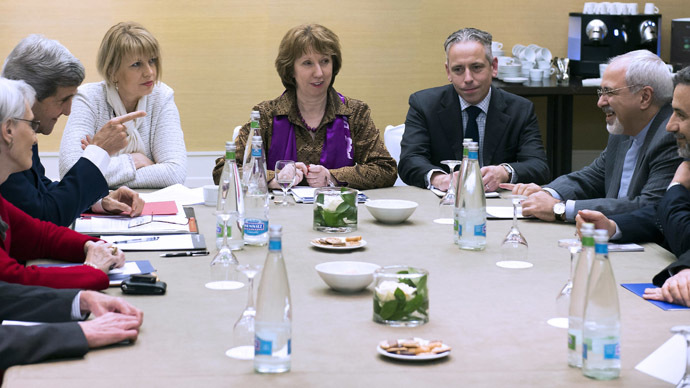Pivotal moment: Why US wants deal with Iran

The Geneva talks between Iran and the P5+1 group may have been torpedoed, but they are not sunk. The possibility of at least an interim deal on Iran’s nuclear program is still on. The saga continues next Wednesday.
Here I have detailed how, and for what turgid motives, France – acting for Israel and the House of Saud - derailed the negotiations last week.
Yet the basic win-win rationale, in the long run, remains. Tehran needs to get rid of the vicious US/Western sanctions package. And Washington wants more leverage in Southwest Asia, and across Eurasia.
Make no mistake; this negotiation is essentially between Washington and Tehran, despite the other players on the table. At the same time, the mere, tantalizing possibility of a deal affects the calculations of every player across Eurasia – from Turkey to BRICS members Russia and China.
Debunking a ‘march to war’
The White House and the State Department are now actively spinning that for the US Congress to impose even more sanctions – on third-party nations trading with Iran – would be “a march to war.” With negotiations failing, President Obama would have no way to stop Iran’s uranium enrichment; hardliners in Tehran would prevail and go for a bomb; and Washington would be forced to attack Iran.
This makes absolutely no sense. To start with, every informed actor – from the IAEA to the alphabet soup of US intelligence agencies and even former Israeli Defense officials - knows that Tehran does not have a weaponized nuclear program. Supreme Leader Ayatollah Khamenei has repeatedly condemned a nuclear weapon as un-Islamic and totally off-limits.
Iran not only does not have - or want - a bomb; it subscribes to the Nuclear Non-Proliferation Treaty (NPT). On the other hand, Israel does not care for the NPT, and is a de facto nuclear power – with warheads in the low hundreds.
Both India and Pakistan eschewed the NPT and built nuclear weapons. This does not mean that they will use them against one another. Their bombs are part of a dissuasion mechanism.
Even considering the very remote possibility that Tehran would abandon its (unstated) policy of reaching breakout nuclear capacity (the so-called ‘Japanese option’) and decide to go for a bomb – without first being attacked by Israel, the US, or both – this would also be part of a dissuasion mechanism.

Washington never sanctioned Israel. On the contrary; it always ‘protected’ Israel’s non-denial denial about being a nuclear power. India and Pakistan were also never sanctioned. So why demonize Iran?
There are, of course, a cornucopia of motives; the impenetrable, 34-year Wall of Mistrust erected between Washington and Tehran after the Islamic Revolution; the fact Washington elites have always wanted regime change; Iran’s independent foreign policy; US corporate desire to access that fabulous energy wealth, not to mention opening up a huge virgin market.
By peddling the logic that failed negotiations would lead to war on Iran, the White House and the State Department are in fact pointing their fingers to their allies, the Likudniks in Israel and the House of Saud, who are already doing everything they can to derail Geneva.
As for war, it is already on – as in financial war, a de facto blockade, with a nasty package of sanctions crippling Iran’s oil exports especially to the West (Asian powers, for their part, have found myriad strategies to dodge the sanctions). It’s this financial war that must be defused.
Attention: Losers whining
The mere possibility of a tectonic geopolitical shift involving Iran has rankled potential ‘losers’ – the Saudi-Israeli axis – to the extreme.
With a deal clinched, Tel Aviv – who US Think Tankland always loves to exalt for bringing ‘balance’ to the Middle East - knows it would lose the pretext of invoking Iran’s fictitious ‘existential threat’ to divert attention from the Mother of All Problems; the occupation/apartheid system in Palestine.
As for the House of Saud, it survives thanks to the petrodollar system – offered ‘protection’, Mob-style, in the form of huge US weapons sales for regulating the oil market, which must be kept on the petrodollar.
Now comes a new confluence in the horizon. Iranian President Hassan Rouhani realized Tehran’s formerly confrontational foreign policy must be recalibrated, as much as Obama refrained at the last minute from plunging ‘exceptional’ America into yet another Middle East war, in Syria; that equally amounts to a confrontational foreign policy redefinition.

It’s also as if a genie had emerged from an Arab Spring lamp somewhere, ‘illuminating’ the Obama administration’s perception. No democracy flower bloomed out of this ‘Spring’. Egypt is back in a de facto military dictatorship. Libya, bombed by NATO, was reduced to a failed state. Syria was hurled into a foreign-imposed civil war. And Bahrain’s legitimate democracy drive was quashed by…Saudi Arabia.
Not to mention that any sort of regime change-style ‘Spring’ is out of the picture in Iran.
So why not talk – starting with the nuclear program?
Tehran’s nuclear program represents most of all an affirmation of regional power. But Rouhani, to his credit, has seen its limits; how it was being perceived by the West as an apocalyptic threat, and how the economic repercussions of the nasty sanctions package was alienating Iranian public opinion.
All this while Obama, with the US out of Iraq and on its way to being (partially) out of Afghanistan, also needed geopolitical repositioning.
It’s ‘pivot to Persia’ time
Once again; the heart of this immensely complex matter is the Washington-Tehran relationship.
‘Great Satan’ v ‘Axis of Evil’: frankly, that’s the stuff of childish cartoon politics. What really matters now are strategic interests doing away with ideology – as much as between China and the US in the early 1970s before that ‘Nixon in China’ moment.
It’s totally unrealistic to expect Washington to ‘pivot away’ from the Middle East, whatever happens. But the Mob racket involving Washington and the House of Saud is a pitiful anachronism. I’m making a public bet: if Tehran were to promise Washington it would always stay within the petrodollar system, a deal about anything would be clinched in no time.
A deep strategic alignment between Tehran and Washington is also wishful thinking – or something that might happen beyond 2020 (when, by the way, China will be the number one economy in the world).
Nevertheless, some consequences of even a partial rapprochement are obvious. Both Washington and Tehran are fighting Salafi-jihadists. The House of Saud switches Salafi-jihadists on and off; it’s OK if you bomb and behead in Iraq or Syria, but not here in Saudi Arabia. It’s not hard to do the subsequent math.
We’re just at the very beginning. Take a good look at this fascinating debate promoted a month ago by the National Iranian American Council (NIAC).
Amid some obvious absurdities, serious points are made about the enormity of it all. And yet, the real thing beckons.
Assuming a nuclear deal (after an interim deal that might be clinched next week or before the end of the year); and assuming the end of sanctions (a long battle between the Obama administration and Capitol Hill), all bets are off.
Imagine Washington-Tehran fighting jihadism together. The US corporate world is already deep into wet dreams of investing in Iran’s energy industry and market. As Tehran’s number one priority is to get rid of the sanctions, it will be fascinating to watch how Washington will deploy its carrots.
Picture Washington teasing Tehran into allowing US corporations to get contracts on equal footing with Iran’s allies China and Russia. Tehran may well use US corporations – as well as European and Asian – to kick start the economy while Washington will use its extended leeway in the whole of Southwest Asia to cut those Wahhabi paradises to size.
Which bring us back to the ‘pivot’ theme. The much-hyped US ‘pivoting to Asia’ – unveiled, significantly, at the Pentagon - implies allies such as Japan, South Korea and Australia essentially containing China.
That’s a long way from happening, and even if it did China will find all sorts of strategic gambits to counteract it. What should be happening first is a pivot by the US itself. Washington/Wall Street elites know that the future of the world economy is in the Asia-Pacific. The 21st is an Asian century. China is already busy integrating the whole of Eurasia – and Iran, as the key node of Southwest Asia, is a crucial actor.
History always comes up with mysterious ways of playing ‘if you can’t beat ’em, join ’em’. For Washington, there will be no real pivot to Asia before a pivot to Persia.
The statements, views and opinions expressed in this column are solely those of the author and do not necessarily represent those of RT.
The statements, views and opinions expressed in this column are solely those of the author and do not necessarily represent those of RT.













